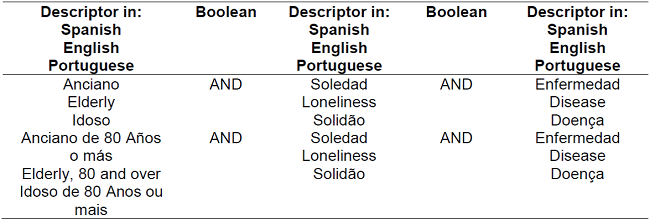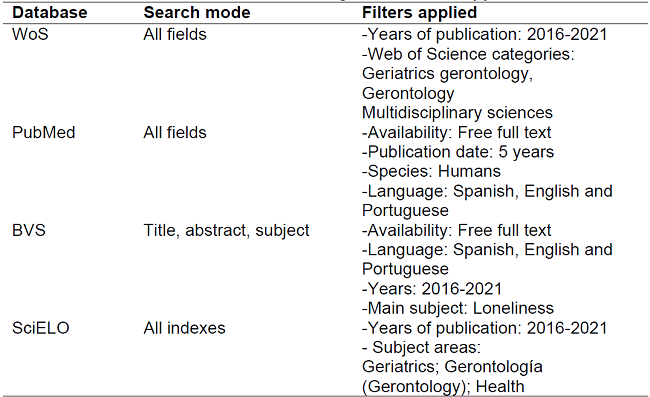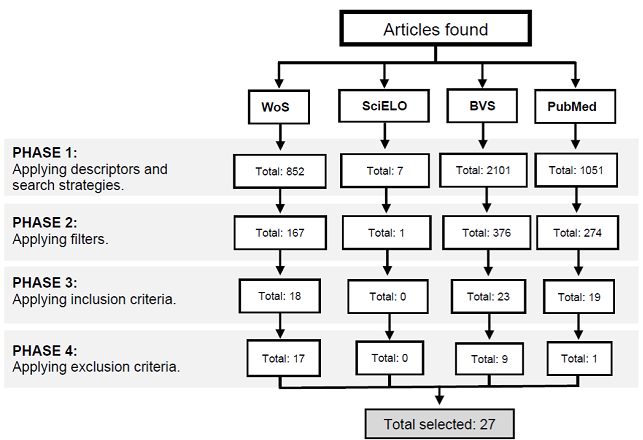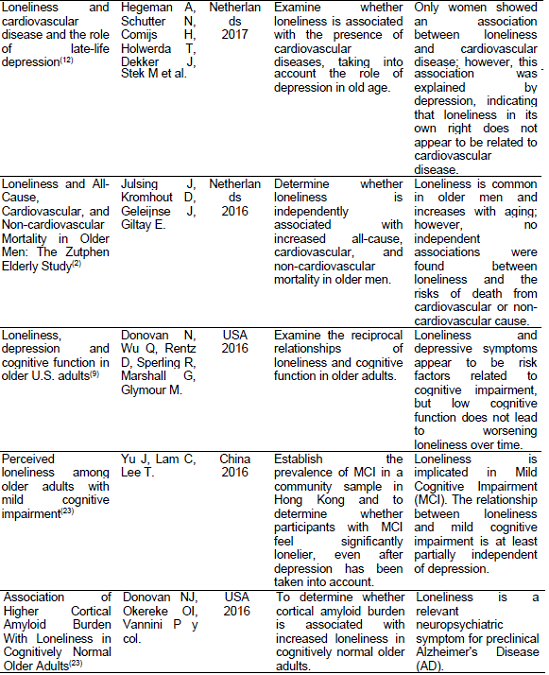Mi SciELO
Servicios Personalizados
Revista
Articulo
Indicadores
-
 Citado por SciELO
Citado por SciELO -
 Accesos
Accesos
Links relacionados
-
 Citado por Google
Citado por Google -
 Similares en
SciELO
Similares en
SciELO -
 Similares en Google
Similares en Google
Compartir
Enfermería Global
versión On-line ISSN 1695-6141
Enferm. glob. vol.22 no.69 Murcia ene. 2023 Epub 20-Mar-2023
https://dx.doi.org/10.6018/eglobal.514761
Reviews
Diseases associated with loneliness in the elderly: a social challenge
1Nursing Department, University of Antofagasta, Antofagasta, Chile
2Nursing School, University of Concepción. Concepción, Chile. osanhue@udec.cl
Methodology:
Secondary research, integrative review type, structured according to Crossetti’s consensus.
Results:
After applying descriptors and search strategies, a total of 4,011 articles were identified, after applying filters, inclusion, and exclusion criteria, 27 articles were selected; from these articles 17 corresponded to WoS, 9 to BVS and 1 to PubMed.
Conclusions:
The association between loneliness and cognitive impairment, decreased physical fitness, Alzheimer's disease and cardiovascular events is highlighted. It is necessary to establish public policies to prepare people for their future aging process.
Keywords: Disease; loneliness; aging; aging for those 80 and over
INTRODUCTION
According to the World Health Organization (WHO), currently the number of people aged 60 years or more exceeds that of children under five years of age; additionally, between 2020 and 2030, the percentage of older people will increase by 34 %, following this pattern, by 2050 the number of older people will exceed that of adolescents and young people between 15 and 24 years of age 1, this phenomenon is known as population ageing.
The above is especially relevant when problems associated with aging, such as loneliness, have been reported 2, which has a negative relationship with the health of older people, with poorer cognitive function, worsening of memory and verbal fluency3. Moreover, this impact on cognitive functioning can exacerbate loneliness, generating a vicious circle that generates an even worse outcome in such population4.
Based on the above, considering that physiologically the body loses functions over the years, which make older people more vulnerable, there are risk factors that can aggravate loneliness, as in the case of the current COVID-19 pandemic, which has been associated with an increase in loneliness 5, and this, in turn, has been strongly related to the presence of anxiety and depression. Therefore, given the demographic change that the world is experiencing, added to the increase in loneliness in the elderly and its association with health problems, it is important to know what has been described in this regard.
OBJECTIVE
Under the above premise, the following question arises: What diseases are associated with loneliness in the elderly? In order to answer this question, an integrative review was considered to know the state of the art, responding to the objective of identifying the pathologies associated with loneliness in the elderly.
METHODS
Secondary research, of the integrative review type, structured, according to Crossetti6, which is comprised by five stages: 1. Problem formulation, 2. Data collection or definitions on literature search, 3. Data evaluation, 4. Data analysis, and finally 5. Presentation of results and interpretation.
To comply with the first stage, the following question was formulated: What diseases are associated with loneliness in the elderly? In the second stage, the different searches were organized in Spanish, English and Portuguese, using the descriptors validated in the DeCS thesaurus and Booleans described in Table No. 1.
The databases used were WoS (Web of Science), PubMed (United States National Library of Medicine), SciELO (Scientific Electronic Library Online) and BVS (Biblioteca Virtual de Salud). Table N°2 shows the search strategies and filters used in each database.
The inclusion criteria used was composed by articles in the three languages mentioned, published in the period ranging from 2016 to 2021 (until June), and that related loneliness as an independent variable and pathologies in the elderly as dependent variables; the exclusion criteria corresponded to articles that do not have free access, duplicates and letters to the editor. Figure N°1 shows the review flowchart.
After applying descriptors and search strategies, a total of 4,011 articles were identified, 852 located in the WoS database, 7 in SciELO, 2,101 in BVS and 1,051 in PubMed; after applying the filters, 818 articles remained, of which 167 corresponded to WoS, 1 to SciELO, 376 to BVS and 274 to PubMed. Then, after applying the inclusion criteria, 60 articles remained, 18 corresponding to WoS, 23 to BVS and 1 to PubMed, and finally, after applying the exclusion criteria, 27 articles were selected 2)(3)(4)(7)(8)(9)(10)(11)(12)(13)(14)(15)(16)(17)(18)(19)(20)(21)(22)(23)(24)(25)(26)(27)(28)(29)(30, of which 17 corresponded to WoS 2)(4)(7)(8)(9)(10)(11)(12)(13)(14)(15)(16)(17)(18)(19)(20)(21, 9 to BVS 3)(22)(23)(24)(25)(26)(27)(28)(29 and 1 to PubMed 30, thus fulfilling stage 3 and 4 of Crossetti.
RESULTS
In compliance with Crossetti’s stage 5 “results presentation and interpretation” the most relevant results of the integrative review are summarized in Table N°3 according to article name, authors, country, year, objective and main results.
Table No. 3. Main results of relationship between loneliness in the elderly and associated pathologies in selected articles.
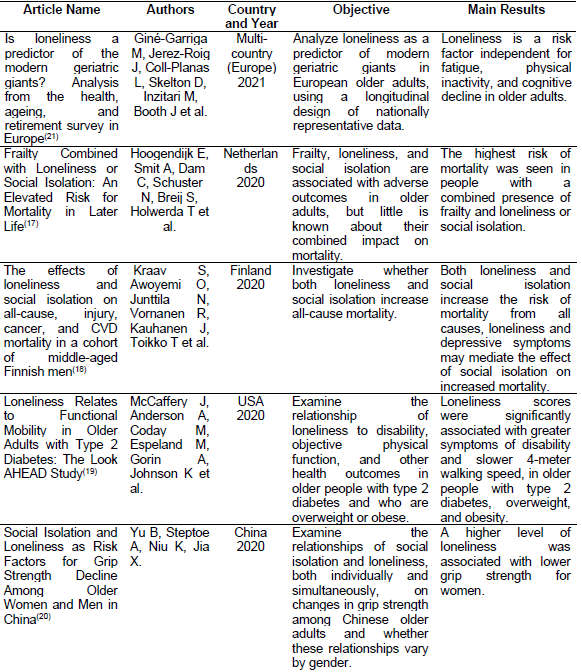
Table No. 3 (cont.). Main results of relationship between loneliness in the elderly and associated pathologies in selected articles.
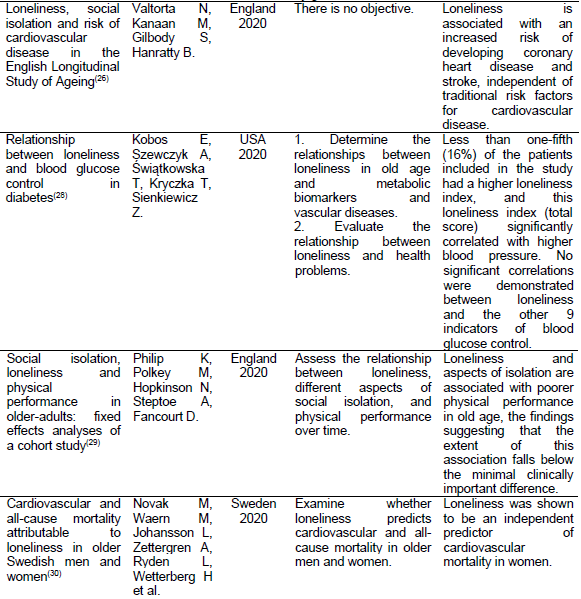
Table No. 3 (cont.). Main results of relationship between loneliness in the elderly and associated pathologies in selected articles.
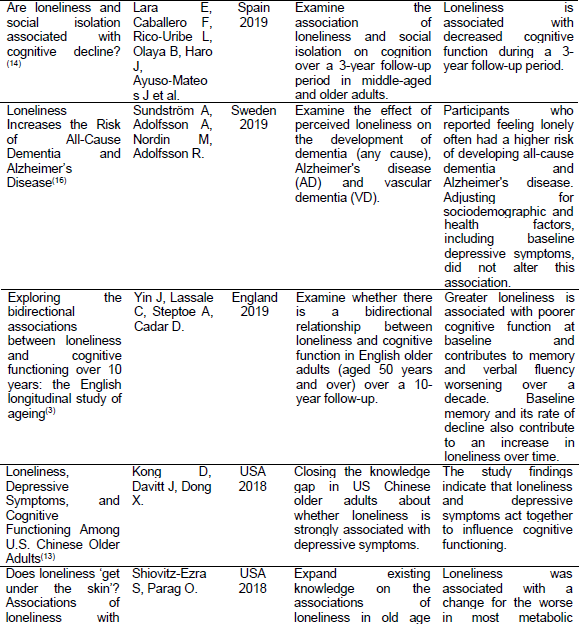
Table No. 3 (cont.). Main results of relationship between loneliness in the elderly and associated pathologies in selected articles.
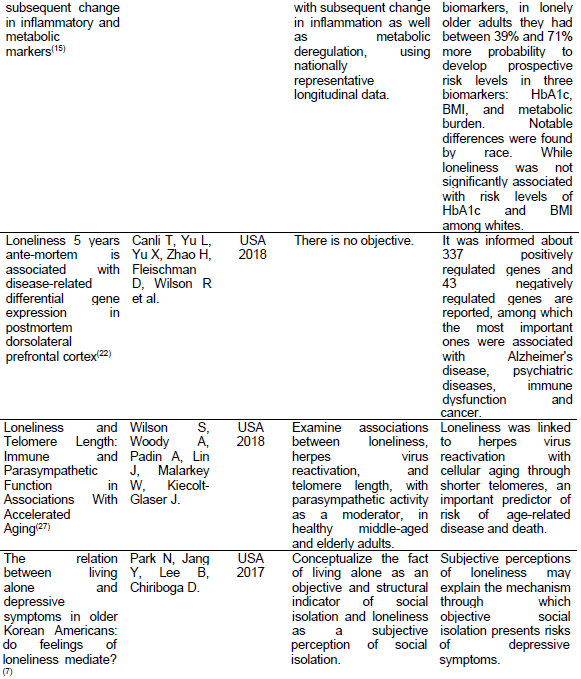
Table No. 3 (cont.). Main results of relationship between loneliness in the elderly and associated pathologies in selected articles.
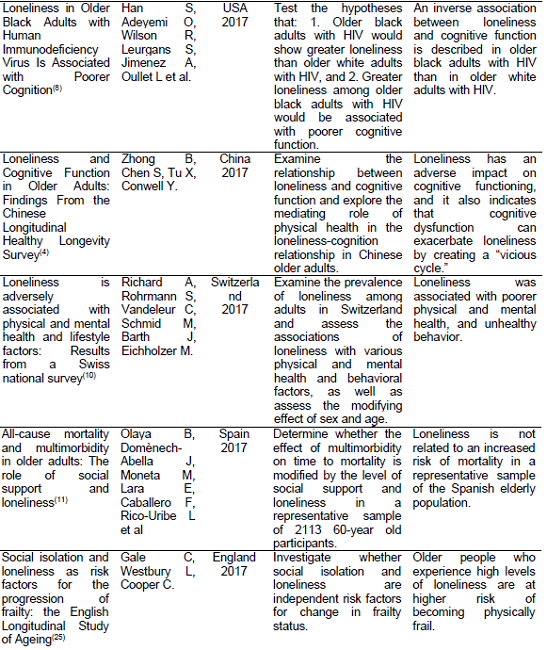
DISCUSSION
Currently there is a large amount of research on the subject 2)(3)(4)(7)(8)(9)(10)(11)(12)(13)(14)(15)(16)(17)(18)(19)(20)(21)(22)(23)(24)(25)(26)(27)(28)(29)(30, recognizing that it is a subject that is being highly researched, demonstrating the efforts to clarify the associations between loneliness and morbidities in the elderly.
The majority of results found a relationship between loneliness and pathologies in the elderly (24 of 27 studies). Associations found between loneliness and death were very diverse, on the one hand, some authors stated that loneliness increases the risk of death 18,27, while others report that there is no such relationship 2,11, likewise, others describe a relationship when there is loneliness concomitantly with frailty 17.
Loneliness as a cause of cognitive impairment was present in all the studies that analyzed it 3)(4)(9)(13)(14)(21)(23, both independently 3)(4)(14)(21)(23, as with association with depressive symptoms 9,13; an important aspect is the description of a “vicious circle”, product of the exacerbation of loneliness due to cognitive dysfunction 4.
Another association identified with loneliness was the physical state of the older adult; in some studies they identified poorer physical health 10, risk of becoming physically frailer 25, poorer physical performance 29, or risk of fatigue and physical inactivity 21.
An interesting aspect to highlight is that in the selected studies that described a relationship associated with one gender, all were linked to women, for example: one article associated loneliness with lower grip strength only in women 20, other authors demonstrated that loneliness is a predictor of cardiovascular mortality in women 30, and another article described a relationship between loneliness and cardiovascular diseases only in women 12; however, in this last study the authors reported that said relationship can be explained by depression, which indicated that loneliness in its own right does not seem to be related to cardiovascular disease, although this is subject to discussion, since in another research loneliness was associated with an increased risk of developing depressive symptoms 7.
Loneliness was also associated with the risk of developing dementia, one study pointed out its relationship with all-cause dementia and Alzheimer's disease 16, another with preclinical Alzheimer's disease 24, and finally, an article associated it with multi-morbidities such as Alzheimer's disease, psychiatric diseases, immune dysfunction and cancer 22.
Regarding the relationship between loneliness and cardiovascular events, one study showed a significant correlation with higher blood pressure 28; additionally, another study related it to a higher risk of developing coronary heart disease and stroke 30. However, another article reported no relationship between loneliness and death from cardiovascular causes 2.
Regarding loneliness and its relationship with race, one study described a significant association between loneliness and risk levels of HbA1c and BMI only in older black adults 15, consistent with another study that compared relationship between loneliness and cognitive function in older adults with HIV, with a greater association in older black adults 8.
Finally, other relationships have been described: such as loneliness with greater symptoms of disability and a slower walking speed of 4 meters in older people with type 2 diabetes, overweight and obesity 19; others associated loneliness with memory and verbal fluency 3, as well as with the reactivation of the herpes virus 27, and it was also associated with poorer mental health and unhealthy behavior 10.
CONCLUSION
The present review fulfilled the objective which was to identify the pathologies associated to loneliness in the elderly. There are multiple studies that show the relationship between loneliness and its consequences, with two trends in some pathologies. On the one hand, studies that affirmed their relationship, while others ruled it out. However, there are clear aspects in the selected studies, for example: the obvious effect of loneliness on cognitive decline, decreased physical fitness, Alzheimer's disease and cardiovascular events. On the other hand, contradictions were seen in the relationship between loneliness and the risk of death, as well as with depression. In this context, it is undeniable that further research is required in this regard, in order to clarify these relationships.
The phenomenon of “population aging” is a challenge for society, since it has to adapt to improve the health and functional capacity of older people as much as possible, as well as their social participation and safety. It is necessary to establish public policies to prepare people for their future aging process, in addition to being able to implement various strategies to prevent and/or reduce loneliness in older people.
REFERENCIAS
1. Organización Mundial de la Salud (OMS), envejecimiento y salud [Internet]. Ginebra: OMS, 2018 [cited on May 22, 2021]. Available at: https://www.who.int/es/news-room/fact-sheets/detail/envejecimiento-y-salud [ Links ]
2. Julsing J, Kromhout D, Geleijnse J, Giltay E. Loneliness and All-Cause, Cardiovascular, and Noncardiovascular Mortality in Older Men: The Zutphen Elderly Study. Am J Geriatr Psychiatry. 2016,24(6):475-484. Available at: https://doi.org/10.1016/j.jagp.2016.01.136 [ Links ]
3. Yin J, Lassale C, Steptoe A, Cadar D. Exploring the bidirectional associations between loneliness and cognitive functioning over 10 years: the English longitudinal study of ageing. Int J Epidemiol. 2019,48(6):1937-1948. Available at: https://doi.org/10.1093/ije/dyz085 [ Links ]
4. Zhong B, Chen S, Tu X, Conwell Y. Loneliness and cognitive function in older adults: findings from the Chinese longitudinal healthy longevity survey. Journals Gerontol Ser B Psychol Sci Soc Sci. 2016,72(1):120-128. Available at: https://doi.org/10.1093/geronb/gbw037 [ Links ]
5. Van der Velden P, Hyland P, Contino C, von Gaudecker H, Muffels R, Das M. Anxiety and depression symptoms, the recovery from symptoms, and loneliness before and after the COVID-19 outbreak among the general population: Findings from a Dutch population-based longitudinal study. PLOS ONE [Internet]. 2021,16(1):e0245057. Available at: https://pubmed.ncbi.nlm.nih.gov/33411843/ [ Links ]
6. Crossetti M da GO. Revisión integrativa de la investigación en enfermería, el rigor científico que se le exige. Rev Gaúcha Enferm [Internet]. 2012,33(2):10-11. Available at: https://doi.org/10.1590/S1983-14472012000200002 [ Links ]
7. Park N, Jang Y, Lee B, Chiriboga D. The relation between living alone and depressive symptoms in older Korean Americans: do feelings of loneliness mediate? Aging Ment Health. 2015,21(3):304-312. Available at: https://doi.org/10.1080/13607863.2015.1099035 [ Links ]
8. Han S, Adeyemi O, Wilson R, Leurgans S, Jimenez A, Oullet L, et al. Loneliness in Older Black Adults with Human Immunodeficiency Virus Is Associated with Poorer Cognition. Gerontology. 2017,63(3):253-262. Available at: https://doi.org/10.1159/000455253 [ Links ]
9. Donovan N, Wu Q, Rentz D, Sperling R, Marshall G, Glymour M. Loneliness, depression and cognitive function in older U.S. adults. Int J Geriatr Psychiatry. 2016,32(5):564-573. Available at: https://doi.org/10.1002/gps.4495 [ Links ]
10. Richard A, Rohrmann S, Vandeleur C, Schmid M, Barth J, Eichholzer M. Loneliness is adversely associated with physical and mental health and lifestyle factors: Results from a Swiss national survey. PLOS ONE [Internet]. 2017,12(7):e0181442. Available at: https://doi.org/10.1371/journal.pone.0181442 [ Links ]
11. Olaya B, Domènech-Abella J, Moneta M, Lara E, Caballero F, Rico-Uribe L, et al. All-cause mortality and multimorbidity in older adults: The role of social support and loneliness. Experimental Gerontology. 2017,99:120-126. Available at: https://doi.org/10.1016/j.exger.2017.10.001 [ Links ]
12. Hegeman A, Schutter N, Comijs H, Holwerda T, Dekker J, Stek M, et al. Loneliness and cardiovascular disease and the role of late-life depression. Int J Geriatr Psychiatry [Internet]. 2017,33(1):e65-72. Available at: https://doi.org/10.1002/gps.4716 [ Links ]
13. Kong D, Davitt J, Dong X. Loneliness, Depressive Symptoms, and Cognitive Functioning Among U.S. Chinese Older Adults. Gerontol Geriatr Med. 2018,4:1-8. Available at: https://doi.org/10.1177/2333721418778201 [ Links ]
14. Lara E, Caballero F, Rico-Uribe L, Olaya B, Haro J, Ayuso-Mateos J et al. Are loneliness and social isolation associated with cognitive decline? Int J Geriatr Psychiatry. 2019,34(11):1613-1622. Available at: https://doi.org/10.1002/gps.5174 [ Links ]
15. Shiovitz-Ezra S, Parag O. Does loneliness 'get under the skin'? Associations of loneliness with subsequent change in inflammatory and metabolic markers. Aging Ment Health. 2018,23(10):1358-1366. Available at: https://doi.org/10.1080/13607863.2018.1488942 [ Links ]
16. Sundström A, Adolfsson A, Nordin M, Adolfsson R. Loneliness Increases the Risk of All-Cause Dementia and Alzheimer's Disease. Journals Gerontol Ser B. 2019,75(5):919-926. Available at: https://doi.org/10.1093/geronb/gbz139 [ Links ]
17. Hoogendijk E, Smit A, Dam C, Schuster N, Breij S, Holwerda T et al. Frailty Combined with Loneliness or Social Isolation: An Elevated Risk for Mortality in Later Life. J Am Geriatr Soc. 2020,68(11):2587-2593. Available at: https://doi.org/10.1111/jgs.16716 [ Links ]
18. Kraav S, Awoyemi O, Junttila N, Vornanen R, Kauhanen J, Toikko T et al. The effects of loneliness and social isolation on all-cause, injury, cancer, and CVD mortality in a cohort of middle-aged Finnish men. A prospective study. Aging Ment Health. 2021,25(12):2219-2228. Available at: https://doi.org/10.1080/13607863.2020.1830945 [ Links ]
19. McCaffery J, Anderson A, Coday M, Espeland M, Gorin A, Johnson K et al. Loneliness Relates to Functional Mobility in Older Adults with Type 2 Diabetes: The Look AHEAD Study. J Aging Res [Internet]. 2020,2020(ID7543702):1-8. Available at: https://doi.org/10.1155/2020/7543702 [ Links ]
20. Yu B, Steptoe A, Niu K, Jia X. Social Isolation and Loneliness as Risk Factors for Grip Strength Decline Among Older Women and Men in China. J Am Med Dir Assoc. 2020,21(12):1926-1930. Available at: https://doi.org/10.1016/j.jamda.2020.06.029 [ Links ]
21. Giné-Garriga M, Jerez-Roig J, Coll-Planas L, Skelton D, Inzitari M, Booth J, et al. Is loneliness a predictor of the modern geriatric giants? Analysis from the survey of health, ageing, and retirement in Europe. Maturitas. 2021,144:93-101. Available at: https://doi.org/10.1016/j.maturitas.2020.11.010 [ Links ]
22. Canli T, Yu L, Yu X, Zhao H, Fleischman D, Wilson R, et al. Loneliness 5 years ante-mortem is associated with disease-related differential gene expression in postmortem dorsolateral prefrontal cortex. Transl Psychiatry. 2018,8(1):1-9. Available at: https://doi.org/10.1038/s41398-017-0086-2 [ Links ]
23. Yu J, Lam C, Lee T. Perceived loneliness among older adults with mild cognitive impairment. Int Psychogeriatrics. 2016,28(10):1681-1685. Available at: https://doi.org/10.1017/S1041610216000430 [ Links ]
24. Donovan NJ, Okereke OI, Vannini P, Amariglio RE, Rentz DM, Marshall GA, et al. Association of higher cortical amyloid burden with loneliness in cognitively normal older adults. JAMA Psychiatry. 2016,73(12):1230-1237. Available at:https://doi.org/10.1001/jamapsychiatry.2016.2657 [ Links ]
25. Gale C, Westbury L, Cooper C. Social isolation and loneliness as risk factors for the progression of frailty: the English Longitudinal Study of Ageing. Age Ageing. 2017,47(3):392-397. Available at: https://doi.org/10.1093/ageing/afx188 [ Links ]
26. Valtorta N, Kanaan M, Gilbody S, Hanratty B. Loneliness, social isolation and risk of cardiovascular disease in the English Longitudinal Study of Ageing. Eur J Prev Cardiol. 2018,25(13):1387-1396. Available at: https://doi.org/10.1177/2047487318792696 [ Links ]
27. Wilson S, Woody A, Padin A, Lin J, Malarkey W, Kiecolt-Glaser J. Loneliness and Telomere Length: Immune and Parasympathetic Function in Associations With Accelerated Aging. Ann Behav Med. 2018,53(6):541-550. Available at: https://doi.org/10.1093/abm/kay064 [ Links ]
28. Kobos E, Szewczyk A, Swiatkowska T, Kryczka T, Sienkiewicz Z. Relationship between loneliness and blood glucose control in diabetes. BMC Public Health. 2020,20(1):1140. Available at: https://doi.org/10.1186/s12889-020-09241-z [ Links ]
29. Philip K, Polkey M, Hopkinson N, Steptoe A, Fancourt D. Social isolation, loneliness and physical performance in older-adults: fixed effects analyses of a cohort study. Sci Rep. 2020,10(1):13908. Available at: https://doi.org/10.1038/s41598-020-70483-3 [ Links ]
30. Novak M, Waern M, Johansson L, Zettergren A, Ryden L, Wetterberg H, et al. Cardiovascular and all-cause mortality attributable to loneliness in older Swedish men and women. BMC Geriatr. 2020,20(1):201. Available at: https://doi.org/10.1186/s12877-020-01603-x [ Links ]
Received: March 09, 2022; Accepted: July 20, 2022











 texto en
texto en 

